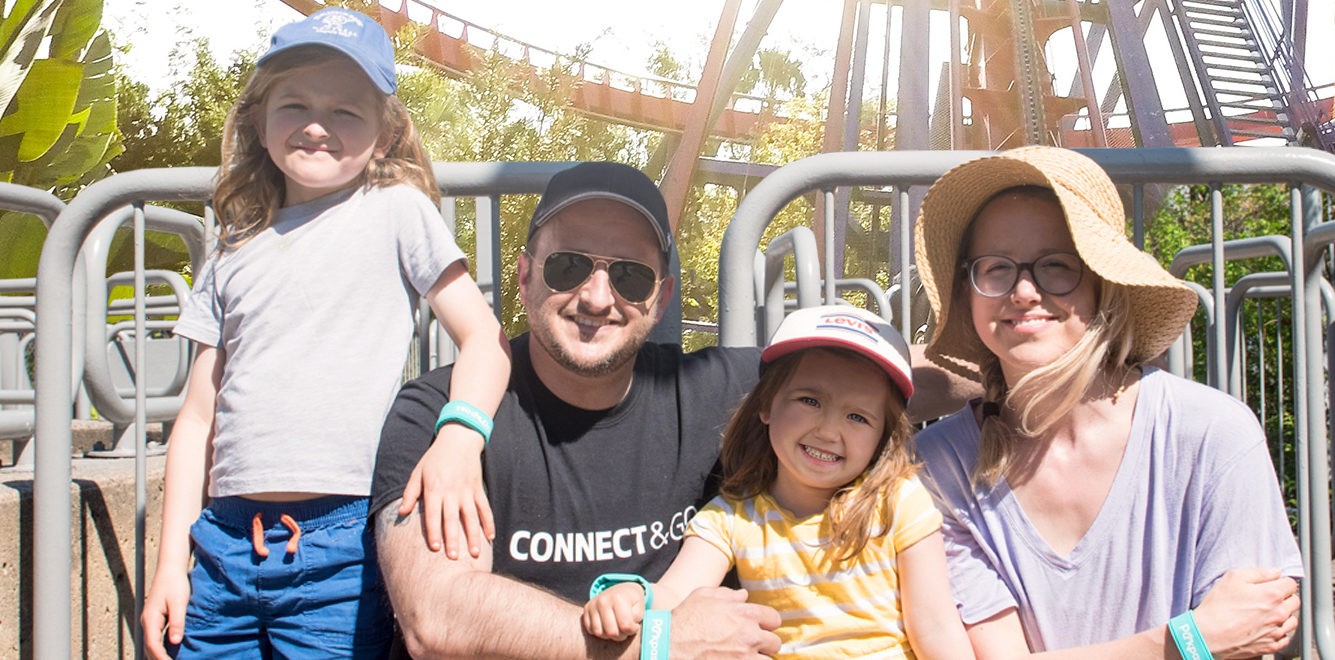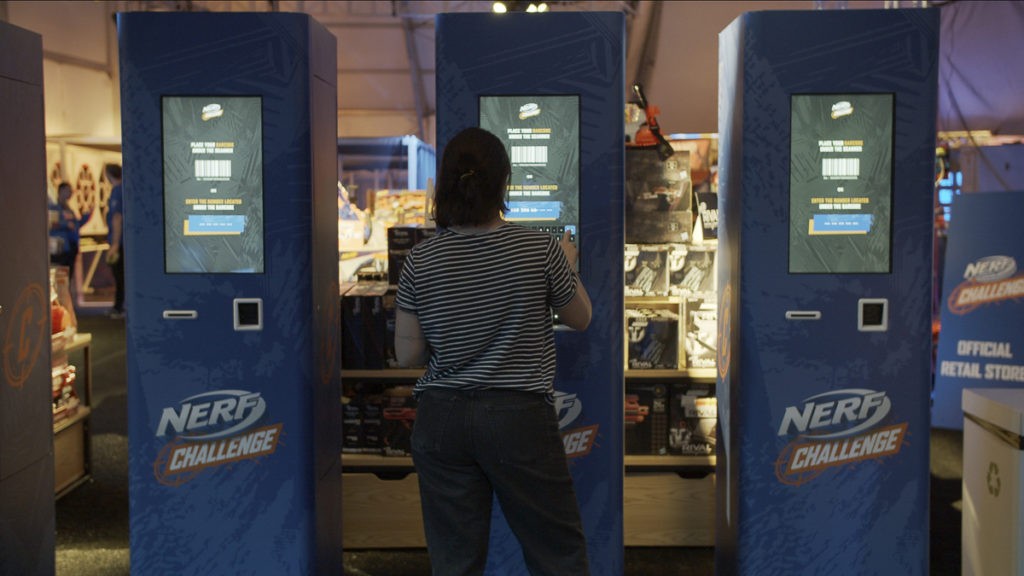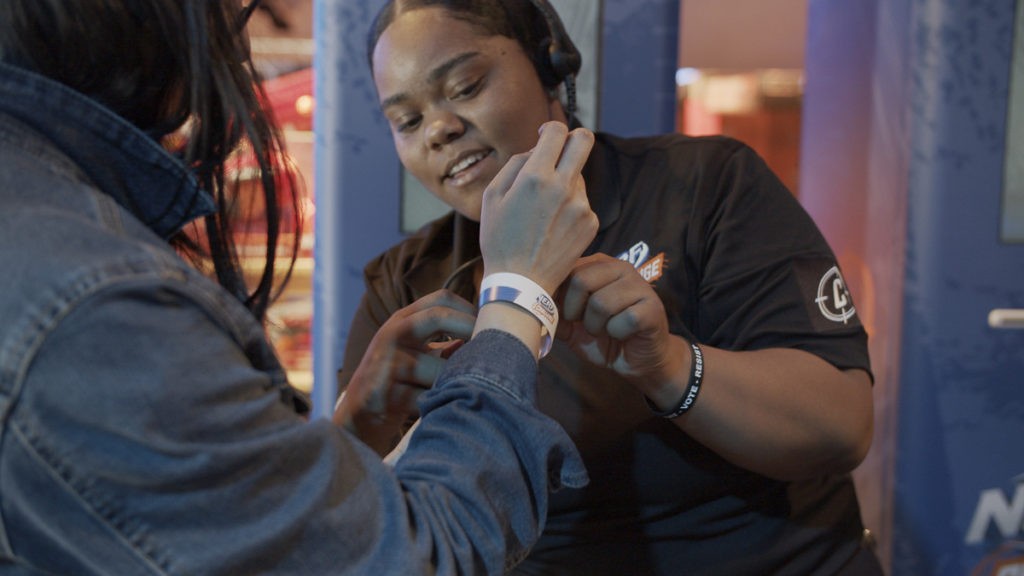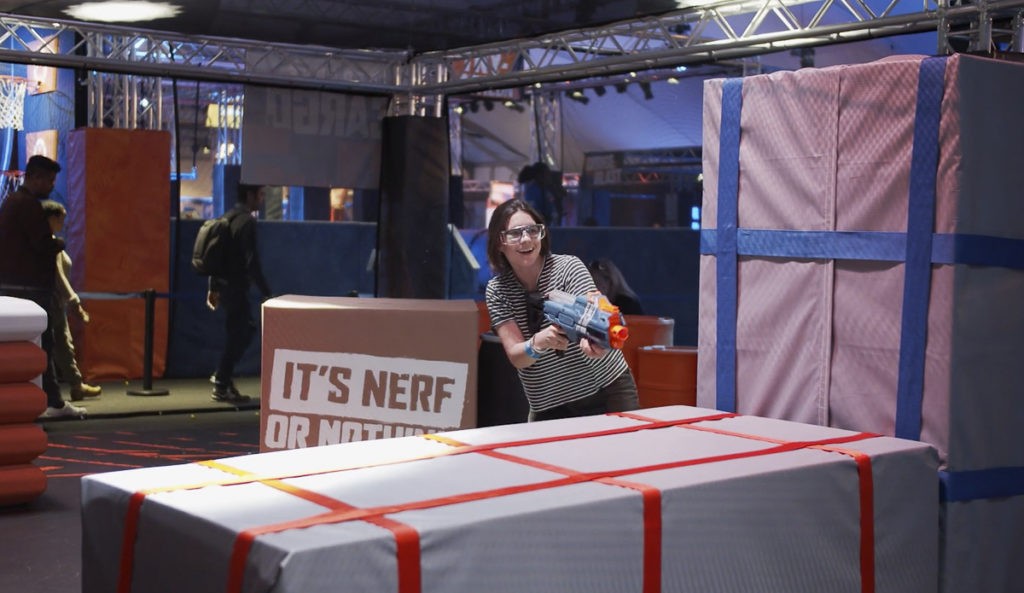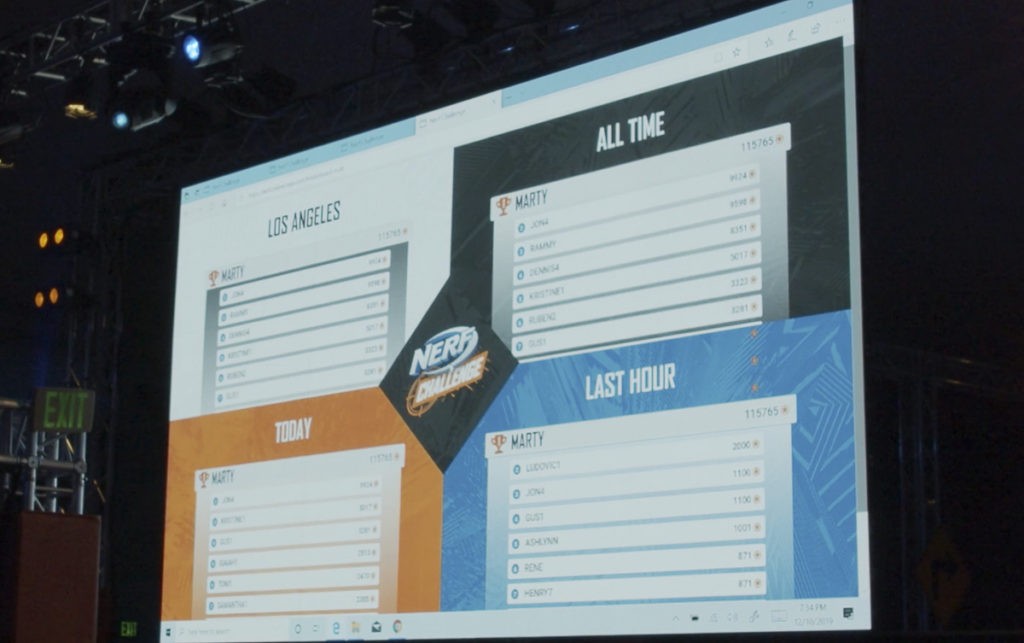The trend of contactless technology is here to stay
by Martin Palicki
ABOVE: Connect&GO Co-Founder Anthony Palermo with his family at a soon-to-open theme park while sporting the company’s ParkPass RFID wristbands. Photo by Daniel Haber. All other photos courtesy of Connect&GO.
Parks and attractions have begun to reopen, and optimism is on the rise. The industry’s strong will to recover is matched by the audiences’ keen desire to return. Creating contactless environments will help keep employees and guests safe in the era of COVID-19, and industry leaders are stepping up to develop solutions.
Connect&GO, with a customer base in parks and attractions and provider of wearable RFID systems that interact with ticketing, POS, queuing and security systems has pivoted to apply its products and expertise to help navigate the reopening process. They even developed a new device that takes the guesswork out of social distancing.
Co-Founder Anthony Palermo built Connect&GO around the idea that “We can provide the best solutions when we listen to the customer and find out what they need.” For the attractions industry, that includes prioritizing the guest experience in the development process. “Even as we think more about contactless environments, we must also be creating a positive interaction for the guest to help ensure they will use the tools we provide,” he says.
Sharing the research; ready for change
As Palermo realized that coronavirus would profoundly impact the leisure industry, he took pro-active steps to reach out to his customer base and find out how Connect&GO might be able to help parks and attractions move forward. He assembled a series of roundtable discussions to talk through the issues. He brought together clients and others they have worked with, including representatives from Canada’s Wonderland, Luna Park, San Diego Zoo, Cirque du Soleil, Disneyland Paris, ProSlide, Triotech and InPark.
The goal of the roundtables was to help Connect&GO understand the needs of the community, but also to provide an opportunity for operators to hear one another’s perspectives. To help disseminate the information even further within the community, Connect&GO recently published a report including key takeaways from the roundtables.
Each roundtable had roughly 20 participants and featured a moderator not affiliated with Connect&GO. Karen Staley, an independent consultant with decades of experience in parks and attractions was one of the moderators. During one roundtable, she shared her viewpoint that there were many benefits to opening as soon as safely possible. “Attractions don’t want to lose their status or branding within the community, so it’s important to open, employ locals and be visible,” said Staley.
The general consensus in the roundtables was that many venues will struggle to be financially successful in 2020, but the immediate concern to most operators was in handling capacity restrictions. Some facilities are looking to a daily cap while others are looking at timed sessions where a group of guests is allowed in for several hours and then large-scale sanitation efforts take place before the next guests are allowed entry.
Any solution a park implements will have to satisfy the demands of three groups: governments, health experts and the public – and reconciling the three won’t always be simple.
Governments are issuing policies for reopening entertainment destinations. Some will have legal teeth behind them, while others will be suggestions. Most will include capacity and distancing restrictions. Second, local health experts may have recommendations that are not necessarily in line with government policies. Finally, the public’s perception of what is safe and appropriate also has to be considered. If people don’t believe a venue is safe, they will not visit it – but they are also ready for change.
What will change? There will be physical procedures primarily for staff, behavioral expectations for guests, and additional technology to support both of those things. Most importantly, accurate and regular communication about these changes will ensure guest expectations align with the experience.
Some attractions are already following this playbook. Energylandia in Poland produced a video showing the new procedures taking place in the park. Six Flags announced their attendance reservation program even before publicizing park opening dates.
“Guests will be expecting a different experience now,” confirmed Staley. “They will not be looking for the same things as before and that is a big benefit for the operator.”
It’s clear that now is the time to make changes that will keep guests safe and also simplify and streamline operations. “Because of the pandemic, guests will be more open to technology now in a way they might not have been just four months ago,” says Palermo.

Anthony Palermo 
Karen Staley 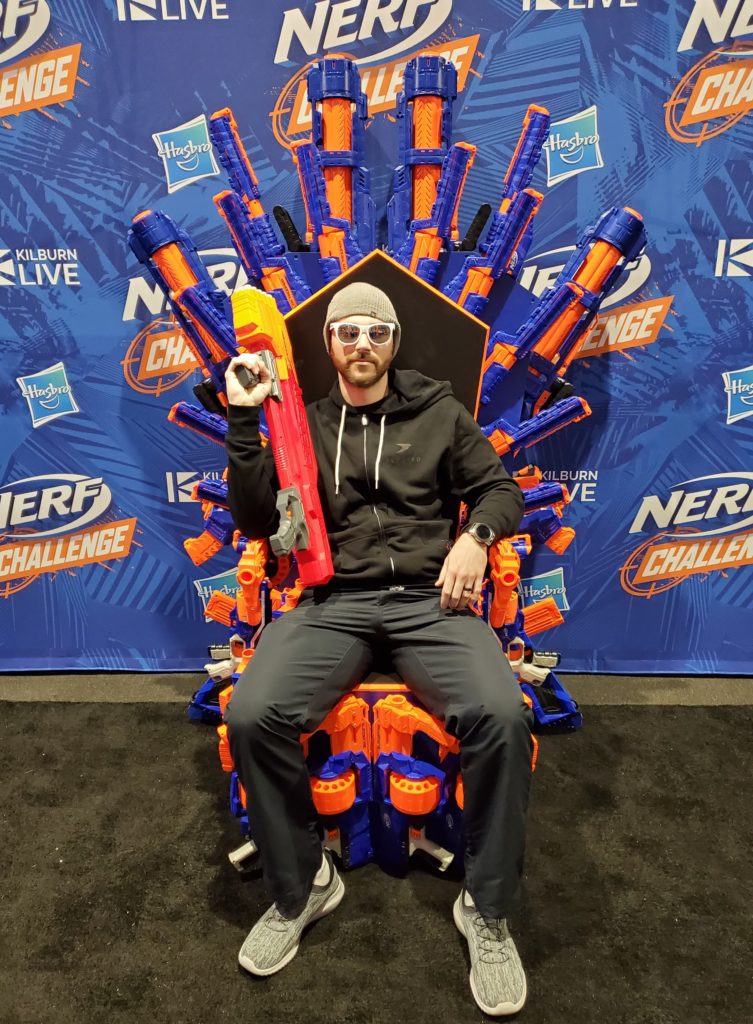
Logan Caldwell 
Richard Guest- Gornall
Contactless: cashless & carefree at attractions
Connect&GO was already on a technology track that fits well with parks’ new priorities, because its basic systems rely on RFID technology to connect guests to services and experiences with minimal need to interact with staff or touch equipment. Guests receive a card or wristband that can be purchased online or at the entrance. The RFID system only requires the device to be moved close to a reader without the need for contact. It becomes a singular touchless device for access to the park, payments within the park, queuing systems, and more. It can be used for elements like lockers and vending machines. Furthermore, since users set up an account in the system, the device also becomes a tool for loyalty and reward programs that can encourage return visitation and enhance revenue streams.
Even before the pandemic, Connect&GO was creating simplified guest-focused transaction systems that also provided a largely contactless experience, like they did for the touring Nerf Challenge, which premiered in Los Angeles in late 2019. Produced by Kilburn Live, event organizers were seeking an RFID solution that was flexible and easy for the guest to use.
“We wanted to create a gamified active play experience with automatic score tracking and reporting for each attendee so that everyone in the family gets to participate in a fun and competitive experience,” says Kilburn Live Production Manager Logan Caldwell. “We needed a seamless integration between software and hardware that simply worked for the guest without effort.”
The experience starts at home with an online ticketing platform that produces a scannable code. Once at Nerf Challenge, guests use a kiosk to scan their code and their RFID wristbands are dispensed from the machine. The kiosk also allows guests to digitally sign a waiver before entering the experience. Connect&GO’s wristbands then give the guest access to nearly a dozen different games and experiences throughout the venue. The system keeps track of scores and displays guests’ names on a giant scoreboard.
Caldwell says guests find the technological integration flawless and the production team has been happy with the Connect&GO solution. “The result of this implementation has put Nerf Challenge in a position to be one of the most unique active play experiences on the market.”
Other parks and attractions had also been moving towards cashless payment systems with more regularity before the pandemic – much of it inspired by Disney’s MagicBand product at the Walt Disney World Resort. “That trend is only going to accelerate because of the pandemic,” says Palermo. “Cash is likely to become a thing of the past.”
With reduced capacity, revenue generation is a heightened concern. Palermo points out that in addition to the safety considerations that contactless systems offer, the device has the potential to increase per capita spending while inside the park, and also provides valuable data for the operator. “Currently, people aren’t talking about big data the way they were a few months ago,” says Palermo. “But data remains extremely valuable and will continue to drive operators towards contactless solutions after the current health and safety concerns are addressed.”
In situations where RFID is not the desired solution, there are a variety of other options for contactless interactions including barcodes, mobile device apps, Bluetooth Low Energy and, more recently, facial recognition. “Some facilities can accomplish everything they want to with barcode or QR code technology,” says Palermo. “We’re interested in matching the technology to what will best support the customer producing optimal return on investment.”
Creating a social distance buzz for parks (literally)
Connect&Go’s standard system assists in creating contactless environments, but the company recently developed SafeBand, a new wristband device designed to take the guesswork out of social distancing. SafeBand relies on Bluetooth technology to communicate with other wristbands. The wristband vibrates and blinks when another person gets within six feet, helping employees learn to self-distance appropriately.
In addition, SafeBand sends its data to a gateway to sync all the information. This creates an effective tool for contact tracing.
Utilizing Bluetooth allows the device to communicate without the need for major new infrastructure. It was designed primarily with employees in mind, but several parks have inquired about using it for guests, according to Palermo, who says, “It is a really pertinent and natural progression of contactless technology.”
Developed in collaboration with two other vendors, SafeBand is an example of how Connect&GO has pivoted to apply its expertise and configure products for reopening in the “new normal.” Palermo explained that SafeBand emerged as a direct response to client needs and the company’s practice of staying in close touch with its customer base.
The experience comes first
While concerns about health and safety are at the forefront now, Palermo doesn’t forget about the importance of providing a great guest experience from start to finish. “Our job has always been to help remove the friction points of an experience and simplify how a guest interacts with an attraction,” says Palermo. “The RFID device is a key that allows the guest to engage with the park. The more engagement there is the more likely they are to enjoy the experience, spend more money, tell others and come back again and again.”
Opportunities to increase revenue must always be in harmony with great guest experience. When a guest doesn’t have to wait in a very long line; when their food order is both correct and timely, they are having a better experience, they are a happier customer and they are likely to spend more money and to visit again in the future. In today’s conditions parks will be challenged to strike the perfect balance.
“When you layer on top of that the fact that the system is cashless and the guest doesn’t have to worry about touching anything, they feel comfortable continuing to engage in an environment that otherwise they might perceive to be risky,” says Palermo. “Those elements have always been a part of RFID systems, but that context is so important right now, and that just makes everything even sweeter for everyone – the employees, the operators, and most importantly, the guests.” • • •
RFID in action: Hyde Park Winter Wonderland
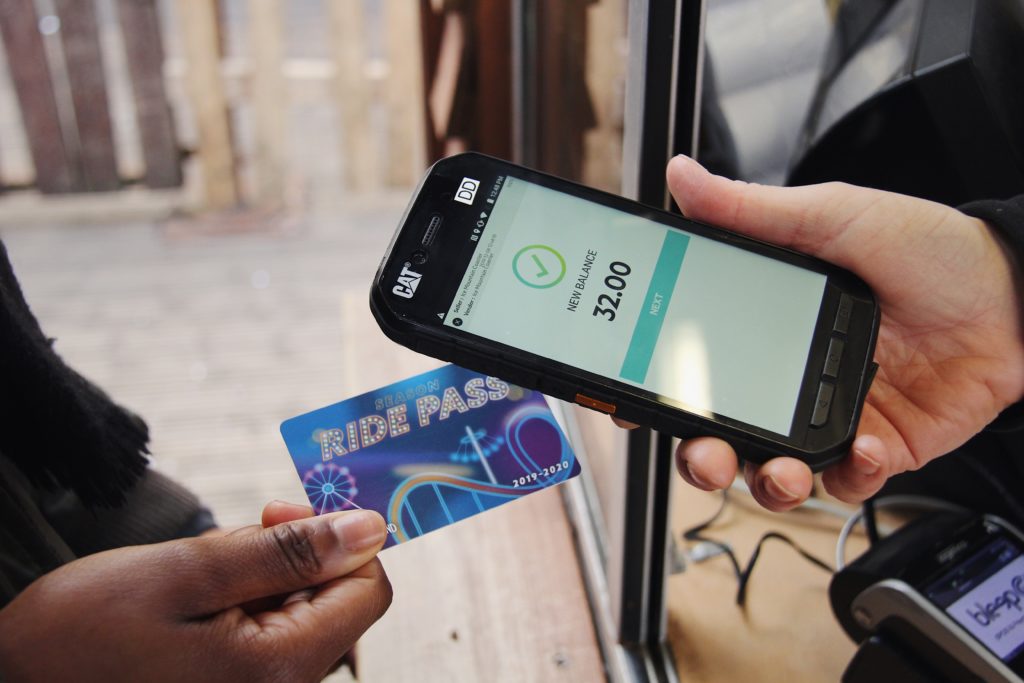
One of Connect&GO’s early customers was Hyde Park Winter Wonderland, produced and operated by IMG. Hyde Park Winter Wonderland is a seasonal attraction in London that combines rides, entertainment, attractions, games and dining into a short winter season. Up until 2018, guests who wanted to ride one of the park’s 70 rides would have to purchase tokens at a booth to exchange with the ride operator.
“We are a free to enter event but were keen to look at means by which our guests could pre-purchase their experiences and RFID was one of the potential solutions,” explains Richard Guest-Gornall, Vice President, Arts & Entertainment Events at IMG.
IMG decided to implement Connect&GO’s RFID card solution (called Coaster Pass) exclusively for the park’s nine roller coasters. Guests could purchase the Coaster Pass online and received bonus credits for adding a certain amount of money to the card. It was primarily intended for the coaster enthusiasts and was a way for the park to experiment with the system without a major rollout. The trial was successful enough that in 2019 they expanded the system to all of the park’s rides, calling it Ride Pass. •
Contactless technology tradeoffs

Mobile device
• Many, but not all, guests already have one with them
• Guest may be more comfortable with their own device
• Can be web-based or an app
• Might require robust WiFi network

Barcodes
• Guest scans barcode with phone and is taken to a website
• Low cost
• Barcode can only mean one thing and can’t be easily updated
• Requires guest to use their own device

Bluetooth Low Energy (BLE)
• Many phones already include BLE but can also be implemented as a wearable device
• Wearables can be expensive per unit
• Not as far a range as normal Bluetooth
• Works for tracking, triangulation, payments and more

Near Field Communication (NFC) RFID
• Wearable devices are cheaper than BLE
• Works for tracking, triangulation, payments and more
• Flexible tool for a variety of situations
• Easily updatable
![]() Connect&GO’s road to the attractions market
Connect&GO’s road to the attractions market
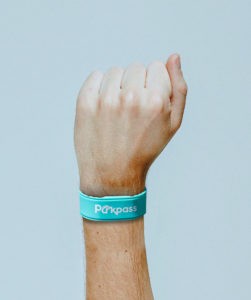
Even before COVID-19 and the roundtables, Palermo built a business on listening to what companies need and developing solutions based on those needs. In the early 2000s Palermo was seeking a new challenge after years working in theater. He searched for “cool tech” online and discovered RFID as an emerging technology. After partnering with some grad students who were studying RFID he managed to get in front of Canadian aerospace manufacturer Bombardier to find out if they had an RFID strategy. His query was successful and for six years he worked with corporations and governments around the world helping them develop plans to integrate RFID solutions into their supply chains and asset management programs.
He was soon approached by a local soccer team that was expanding their stadium. The team wanted to “give people the keys to the stadium” and find ways to let their fans unlock all sorts of interactivity during a game. This led to a wearable RFID device that worked as an entry ticket, cashless purchase system and also activated experiences around the stadium, earning fans points and discounts for future visits. Palermo called the system, and his company, Connect&GO. This RFID system that integrated ticketing, POS, security, promotions and gamification into one package became the backbone of the new company.
The technology quickly became popular in the world of events and brand activations. Connect&GO produced the RFID technology backbone for music festivals and stadium tours. High-profile events like Comic-Con, SXSW, the Super Bowl and the Olympic Village at the PyeongChang 2018 Olympic Winter Games were powered by Connect&GO.
By 2017 Palermo realized it was time to diversify into other markets. In addition to touring and temporary locations, Connect&GO moved decisively into the attractions and leisure space. •


